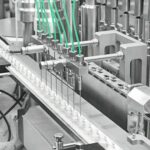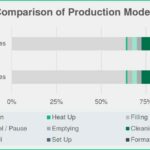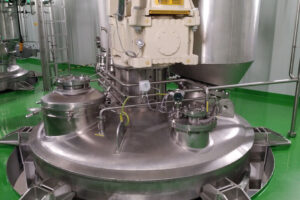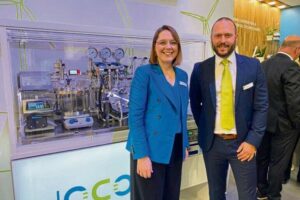Companies in the pharmaceutical industry are increasingly aiming for resource efficiency and ecological processes. Boehringer Ingelheim, for example, plans to achieve CO2 neutrality by 2030 (Scope 1 and 2). Bayer AG is aiming for zero net greenhouse gas emissions by 2050. There are numerous ways to achieve those goals: electricity and compressed air from ecological sources, alternative packaging materials, or modified production processes can pave the way to more sustainable production in the long term.
Data is the key
However, if technological and process-related adjustments are to succeed, they need another important resource that is far less obvious than the systems and products themselves – data. Quantified consumption and emissions allow manufacturers to draw conclusions and make adjustments at machine or process level. Besides sufficient time, comprehensive data collection requires a calculation methodology that is appropriate for existing systems such as a filling line for liquid pharmaceuticals. The approach needs to accurately record electricity and media consumption like water and compressed air, and to allocate the values to different operating modes and machines. This way, it can provide a holistic overview of consumption at different times.
Siegfried, a pharmaceutical contract manufacturer based in Switzerland and with production sites in Germany, has tackled this task together with a well-versed expert who also supplies the filling systems. Syntegon has recently developed its own calculation model based on so-called Life Cycle Assessments (LCA). The method allows the company to evaluate energy consumption and emissions during the entire life cycle of its machines. Following extensive in-house calculations based on empirical values, the experts in processing and packaging technology have carried out an LCA using data from the contract manufacturer.
Practical implementation
“On the one hand, Siegfried wanted to determine emission savings associated with green energy,” Steffen Carbon, responsible for sustainable product design at Syntegon, recalls. “On the other hand, the company was eager to understand the effects of modified production processes on the overall emissions at their German site. After all, the filling line accounts for around a tenth of the site‘s energy consumption. This gave us the opportunity to carry out LCA calculations with specific production data for the first time.”
Siegfried operates several Syntegon filling lines for various liquid pharmaceuticals, including filling, capping, and crimping machines for glass containers as well as sterilizing and cleaning equipment. Process systems to produce water for injection (WFI) are also part of Siegfried’s set-up. The company switched from conventional electricity from a local supplier to certified electricity from renewable energy sources such as wind and water to ensure the ecological operation of all components. Moreover, a nearby waste incineration plant provides steam for WFI production. An efficient compressed air system further supplies machine parts and cleaning systems with compressed air.
Insightful findings
“The company didn‘t know exactly how these adjustments would affect its emissions. Our analysis provided transparency, especially as all the machines on site are from the vast Syntegon portfolio. If needed, we were able to draw on existing data from our respective production sites to complete the analysis,” says Steffen Carbon. Syntegon’s experts and Siegfried‘s production specialists compiled the data over the course of a week. “We defined beforehand what information we needed, such as data on electricity and steam consumption, compressed air, and WFI. We correlated this with material values from a specialized database to determine the actual emissions of each category.”
Up to 80 percent
The results of the comprehensive calculations: by using green electricity, self-generated steam, and compressed air, Siegfried reduces its CO2 emissions by up to 80 %. WFI generation contributes around 50 %, while the use of electricity for all machines accounts for a third. The rest relates to compressed air generation. “This is a remarkable result that proves two things: major savings can be achieved with appropriate resource adjustments. However, we can also see that a large share of the emissions is still generated during the utilization phase when using green energy, which in this case still causes two thirds of the emissions over the life cycle. This phase is therefore the most important area for further reductions.”
Campaign filling
A second calculation, which focused on the effects of modified production processes on CO₂ emissions, demonstrated the potential of such a change. Instead of running several individual batches, the CDMO relies on so-called campaign filling, i. e. several batches in combination. This reduces format changes, such as adjustments to mechanical components, and cleaning to a minimum. The time-saving process has a noticeable effect on emissions. “Here, too, we collected data on the different production cycles and took a close look at the operating modes. How much energy does the filling line need during operation? How much in standby mode?” explains Carbon.
The evaluation of the average times for individual and campaign batches reveals that Siegfried saves up to 20 % in emissions during campaign operation. “Significantly reduced format changes and the one-off setting for campaign filling do the trick,” says Steffen Carbon. While the specific project largely focused on ongoing operations, the expert recommends that companies evaluate other modes as well: “Detailed analyses, for example of the various standby modes, are necessary to determine how much energy is really needed during non-productive times. Operators have several options to effectively control resource consumption and emissions,” the expert points out.
The course for the future
Syntegon’s analyses provide key insights in both cases. “We are currently at the beginning of evaluating our LCA. Further adjustments to production processes could be an option, based on detailed emission analyses at product and packaging material level, which we can also cover,“ he explains. Determining the influence of packaging materials such as glass on emissions is a further possibility. The LCA is not an end in itself but offers important guidance that companies can take into account when carefully planning and fulfilling regulatory requirements – and that point the way to a world with less negative environmental impact.
Hall 3.1, Stand C71










